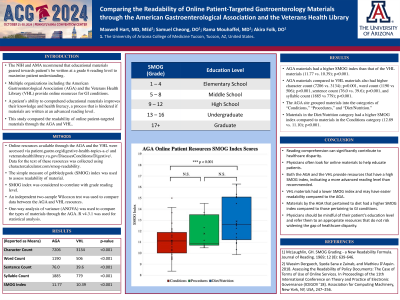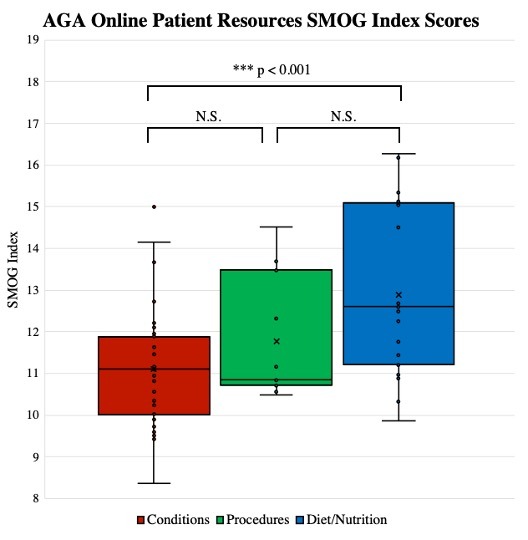Sunday Poster Session
Category: Practice Management
P1485 - Comparing the Readability of Online Patient-Targeted Gastroenterology Resources Through the American Gastroenterological Association and the Veterans Health Library
Sunday, October 27, 2024
3:30 PM - 7:00 PM ET
Location: Exhibit Hall E


Maxwell Hart, MD
Banner - University of Arizona
Tucson, AZ
Presenting Author(s)
Maxwell Hart, MD, Samuel H. Cheong, DO, Rama Mouhaffel, MD, Akira Folk, DO
Banner - University of Arizona, Tucson, AZ
Introduction: The National Institute of Health and American Medical Association recommend that educational materials for patients be written at a grade 6 reading level to maximize patient understanding. Multiple organizations including the American Gastroenterological Association (AGA) and the Veterans Health Library (VHL) provide online resources for GI conditions. A patient’s ability to comprehend educational materials improves their knowledge and health literacy, a process that is hindered if materials are written at an advanced reading level. This study compared the readability of online patient-targeted materials through the AGA and VHL.
Methods: Online resources available through the AGA and the VHL were accessed via patient.gastro.org/digestive-health-topics-a-z/ and veteranshealthlibrary.va.gov/DiseasesConditions/Digestive/. Data for the text of these resources was collected using charactercalculator.com/smog-readability. The simple measure of gobbledygook (SMOG) index was used to assess readability of material. In accordance with prior studies, SMOG index was considered to correlate with grade reading level. An independent 2-sample Wilcoxon test was used to compare data between the AGA and VHL resources. One-way analysis of variance was used to compare the types of materials through the AGA. R v4.3.1 was used for statistical analysis.
Results: AGA materials had a higher SMOG index than that of the VHL materials (11.77 vs. 10.39); p< 0.001. AGA materials compared to VHL materials also had higher character count (7206 vs. 3134); p< 0.001, word count (1190 vs 506); p< 0.001, sentence count (76.0 vs. 39.6); p< 0.001, and syllable count (1885 vs 779); p< 0.001. The AGA site grouped materials into the categories of “Conditions,” “Procedures,” and “Diet/Nutrition.” Materials in the Diet/Nutrition category had a higher SMOG index compared to materials in the Conditions category (12.89 vs. 11.10); p< 0.001.
Discussion: Reading comprehension can contribute to healthcare disparity. Physicians often look for online materials to help educate patients. Both the AGA and the VHL provide resources that have a high SMOG index, indicating a more advanced reading level than recommended. VHL materials had a lower SMOG index and may have easier readability compared to the AGA. Materials by the AGA that pertained to diet had a higher SMOG index compared to those pertaining to GI conditions. Physicians should be mindful of a patient’s education level and refer them to an appropriate resources that do not risk widening the gap of healthcare disparity.

Note: The table for this abstract can be viewed in the ePoster Gallery section of the ACG 2024 ePoster Site or in The American Journal of Gastroenterology's abstract supplement issue, both of which will be available starting October 27, 2024.
Disclosures:
Maxwell Hart, MD, Samuel H. Cheong, DO, Rama Mouhaffel, MD, Akira Folk, DO. P1485 - Comparing the Readability of Online Patient-Targeted Gastroenterology Resources Through the American Gastroenterological Association and the Veterans Health Library, ACG 2024 Annual Scientific Meeting Abstracts. Philadelphia, PA: American College of Gastroenterology.
Banner - University of Arizona, Tucson, AZ
Introduction: The National Institute of Health and American Medical Association recommend that educational materials for patients be written at a grade 6 reading level to maximize patient understanding. Multiple organizations including the American Gastroenterological Association (AGA) and the Veterans Health Library (VHL) provide online resources for GI conditions. A patient’s ability to comprehend educational materials improves their knowledge and health literacy, a process that is hindered if materials are written at an advanced reading level. This study compared the readability of online patient-targeted materials through the AGA and VHL.
Methods: Online resources available through the AGA and the VHL were accessed via patient.gastro.org/digestive-health-topics-a-z/ and veteranshealthlibrary.va.gov/DiseasesConditions/Digestive/. Data for the text of these resources was collected using charactercalculator.com/smog-readability. The simple measure of gobbledygook (SMOG) index was used to assess readability of material. In accordance with prior studies, SMOG index was considered to correlate with grade reading level. An independent 2-sample Wilcoxon test was used to compare data between the AGA and VHL resources. One-way analysis of variance was used to compare the types of materials through the AGA. R v4.3.1 was used for statistical analysis.
Results: AGA materials had a higher SMOG index than that of the VHL materials (11.77 vs. 10.39); p< 0.001. AGA materials compared to VHL materials also had higher character count (7206 vs. 3134); p< 0.001, word count (1190 vs 506); p< 0.001, sentence count (76.0 vs. 39.6); p< 0.001, and syllable count (1885 vs 779); p< 0.001. The AGA site grouped materials into the categories of “Conditions,” “Procedures,” and “Diet/Nutrition.” Materials in the Diet/Nutrition category had a higher SMOG index compared to materials in the Conditions category (12.89 vs. 11.10); p< 0.001.
Discussion: Reading comprehension can contribute to healthcare disparity. Physicians often look for online materials to help educate patients. Both the AGA and the VHL provide resources that have a high SMOG index, indicating a more advanced reading level than recommended. VHL materials had a lower SMOG index and may have easier readability compared to the AGA. Materials by the AGA that pertained to diet had a higher SMOG index compared to those pertaining to GI conditions. Physicians should be mindful of a patient’s education level and refer them to an appropriate resources that do not risk widening the gap of healthcare disparity.

Figure: Figure 1
Note: The table for this abstract can be viewed in the ePoster Gallery section of the ACG 2024 ePoster Site or in The American Journal of Gastroenterology's abstract supplement issue, both of which will be available starting October 27, 2024.
Disclosures:
Maxwell Hart indicated no relevant financial relationships.
Samuel Cheong indicated no relevant financial relationships.
Rama Mouhaffel indicated no relevant financial relationships.
Akira Folk indicated no relevant financial relationships.
Maxwell Hart, MD, Samuel H. Cheong, DO, Rama Mouhaffel, MD, Akira Folk, DO. P1485 - Comparing the Readability of Online Patient-Targeted Gastroenterology Resources Through the American Gastroenterological Association and the Veterans Health Library, ACG 2024 Annual Scientific Meeting Abstracts. Philadelphia, PA: American College of Gastroenterology.
